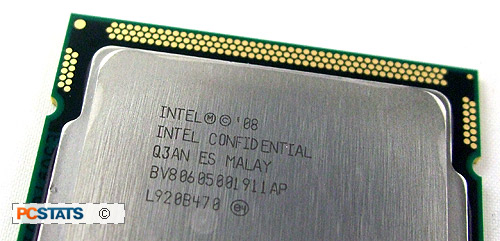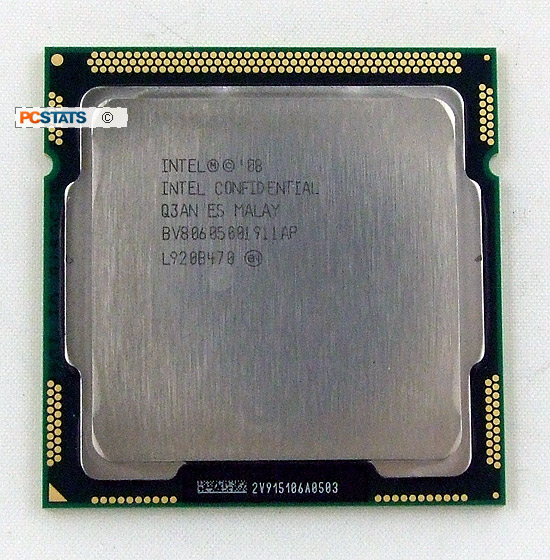 |
| Overclocking Results: |
|
|
Intel's Core i5 processors slip into a new class of
motherboards with 1156-pin CPU sockets, following in AMD's integrated memory
controller footsteps and take on much of the responsibilities previously
relegated to the motherboard's northbridge chipset. In other words, a lot has
changed. Overclocking methodologies change along with CPU architectures, but
this time around the good old Front Side Bus is nowhere to be seen, replaced by
a similar number called BCLK - base clock. Architectural CPU changes bring about
new challenges, new possibilities and of course, new overclocking potential!
The Intel Core i5 750 is ripe with overclocking
potential if we are to believe the rumors from enthusiast forums. In this
section PCSTATS is going to try and overclock the Core i5 750 by at least 1 GHz!
PCSTATS is still finding its feet with Core i5
overclocking, but from what we're seeing the choice of motherboard plays an
important role. PCSTATS will be overclocking the Intel Core i5 750 processor
(S-Spec: SLBCH) on Gigabyte's GA-P55-UD6 motherboard, an Intel P55 Express
platform with a BCLK headroom of about 210MHz according to our tests.
 Before the Core i5 750 overclocking
commenced, PCSTATS installed two sticks of 2GB Corsair CMD4GX3M2A1600C8 DDR3
RAM. High quality, low latency memory is the cornerstone of a successful
overclocking attempt, and Corsair is among the best performance memory makers
out there. The Corsair CMD4GX3M2A1600C8 memory was set to run in DDR3-1333 MHz
mode, so as not to hold the CPU back. All CPU speed throttling options were
disabled in the BIOS, including C1E state, and Speedstep/EIST. The standard
Intel reference socket 1156 heatsink was used for cooling.
Before the Core i5 750 overclocking
commenced, PCSTATS installed two sticks of 2GB Corsair CMD4GX3M2A1600C8 DDR3
RAM. High quality, low latency memory is the cornerstone of a successful
overclocking attempt, and Corsair is among the best performance memory makers
out there. The Corsair CMD4GX3M2A1600C8 memory was set to run in DDR3-1333 MHz
mode, so as not to hold the CPU back. All CPU speed throttling options were
disabled in the BIOS, including C1E state, and Speedstep/EIST. The standard
Intel reference socket 1156 heatsink was used for cooling.
Keeping the Core i5 750's clock multiplier set to 20x,
the base clock was slowly increased from 133MHz towards 200 MHz. The highest
speed we successfully POSTed at was 205MHz BCLK (effective 4.1GHz CPU speed)!
Not shabby at all. To get the PC stable enough to load Windows Vista required a
little more fine tuning, and after a few minutes of this we settled on a very
nice overclock of 20 x 197MHz = 3.94GHz with the Intel Core i5 750
processor.
That's an overclock of
1.28GHz over the processor's default clock speed of 2.666GHz!
Of course, even if you don't overclock your processor
manually, you can still take advantage of the Core i5 750's large amounts of
headroom through enabling Turbo Boost. Turbo doesn't give quite as big a boost
as manual overclocking does, but it is a lot easier to manage automatically.
Prelude to Benchmarks
Over the following page we'll be running
Intel's 2.66GHz Core i5 750 processor though PCSTATS standard set of gaming,
productivity, and multi-threaded processor benchmarks. There are a wide variety
of gaming and synthetic benchmarks here to illustrate what kind of performance
boost users can expect from the latest quad-core socket LGA1156 Intel processor.
Please take a moment to look over PCSTATS test system configurations before
moving on to the individual benchmark results on the next several pages.

PCSTATS is running benchmarks for the Intel
Core i5 750 processor under Microsoft Windows Vista and Microsoft Windows 7, to
get an idea of how Intel's most recent line of mainstream processors will fare
as well as indication of overall system performance in Microsoft Windows 7.
 |
| PCSTATS Test System Configurations |
|
reference system #1 |
test system |
reference system #2 |
reference system #3 |
| processor: |
amd Phenom II X4 965 Black Edition
AMD Phenom II X4 955 Black
Edition
AMD Phenom II X3 720 Black
Edition
AMD Phenom II X2 550 Black Edition
AMD Athlon II X4 620
AMD Athlon II X3 435
AMD Athlon II X2 250
AMD Athlon II X2 240e |
Intel Core i5
750 |
Intel Core i7 920 |
Intel Core 2 Duo E8500
Intel Core 2 Duo E8400 |
| CPU
Process Technology: |
45nm |
45nm |
45nm |
45nm |
| Socket: |
Socket AM3 |
Socket
LGA1156 |
Socket
LGA1366 |
Socket
LGA775 |
| Clock
Speed: |
17x200 MHz = 3.4 GHz (965 BE)
16x200 MHz = 3.2 GHz (955 BE)
14x200 MHz = 2.8 GHz (720 BE)
15.5x200 MHz = 3.1 GHz (550BE)
13x200 MHz = 2.6 GHz (AIIX4 620)
14.5x200 MHz = 2.9 GHz (AIIX3 435)
15x200 MHz = 3.0 GHz (AIIX2 250)
14x200 MHz = 2.8 GHz (AIIX2 240e)
|
20x 133MHz = 2.66 GHz< /STRONG >
|
20 x 133 MHz =
2.67 GHz |
9.5 x 333 MHz =
3.16GHz (E8500)
9 x 333 MHz = 3.0GHz
(E8500) |
| Motherboard: |
Gigabyte GA-MA790FXT-UD5P (AMD
790FX) |
Gigabyte GA-P55-UD6 (Intel P55)
|
MSI X58 Platinum
(X58 Express) |
MSI X48
Platinum (X48 Express) |
| Videocard: |
ASUS ENGTS250 DK
(Geforce GTS250) |
ASUS ENGTS250 DK
(Geforce GTS250) |
ASUS ENGTS250 DK
(Geforce GTS 250) |
MSI NX8800GTS-T2D320E
(Geforce 8800GTS) |
| Memory: |
2x2GB Corsair XMS3-1600C9 DDR3
2x1GB Patriot PDC32G1600LLK DDR3 |
2x2GB Corsair XMS3-1600C8
DDR3 |
3x2GB Corsair TR3X6G1600C8D
DDR3 |
2x1GB Patriot PDC32G1600LLK DDR3 |
| Hard
Drive: |
74GB Western Digital Raptor WD740 |
| Optical Drive: |
ASUS BC-1205PT-BD |
| Power
Supply: |
PC Power & Cooling TurboCool 750W |
| Heatsink: |
Athlon64 K8 Reference Heatsink |
Intel Reference
1156 Heatsink |
Intel Reference
1366 Heatsink |
Intel Reference 775 Heatsink |
| Software Setup: |
Microsoft
Windows Vista Ultimate
Microsoft Windows 7
Ultimate
AMD Catalyst 9.8
nVIDIA Forceware 190.62 |
Microsoft
Windows Vista Ultimate
Microsoft Windows 7
Ultimate
Intel 9.1.1.1019
nVIDIA Forceware 190.62 |
Microsoft
Windows Vista Ultimate
Intel INF
9.1.0.1012
nVIDIA Forceware
182.08 |
Microsoft
Windows Vista Ultimate
Intel INF
9.0.0.1008
nVIDIA Forceware
169.25 |
| Benchmarks: |
System Benchmarks:
SYSmark 2007
PCMark Vantage
SiSoft Sandra 2009 |
Calculation B/M:
Super Pi 1.5
wPrime 2.0
ScienceMark 2.3
WinRAR 3.8
Bibble
5 |
Rendering
B/M:
Cinebench R10
POV-Ray 3.7
SPECviewPerf 10 |
Gaming
B/M:
3DMark06
3DMark Vantage
Cyrsis
FEAR
| | |
